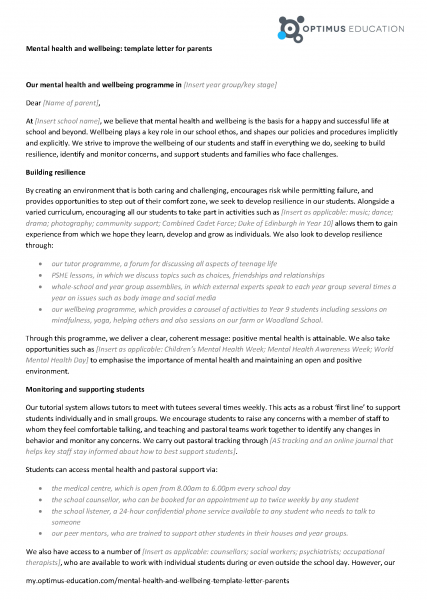- Latest NewsUp-to-date articles giving you information on best practice and policy changes.
- Skills AuditsEvaluate your skills and knowledge, identify gaps and determine training needs.
Pupil mental health and wellbeing: guidance for staff
If you are a staff member in any role, use these resources to recognise the many facets of mental health, and to support the children and young people in your care
Go straight to
While you are not expected to be a mental health expert or to diagnose conditions, the links and resources here are a starting point for understanding the issues and providing support.
Mental health and wellbeing have become particularly important topics as a result of the Covid-19 pandemic. During and after lockdown, some pupils – and staff – may have experienced domestic abuse, loneliness, isolation and mental health issues.
These issues can manifest themselves in anything from anxiety and depression to self-harm and eating disorders.
Recognising the signs of stress
The RSE curriculum now requires all pupils to be taught about mental wellbeing. This includes explaining, in a classroom setting, how they can understand and manage their emotions, so that everyone has a shared knowledge and language to help them recognise potential issues.
It is also important for staff to spot the signs that pupils may be struggling and the behaviours that provide an early warning that further intervention may be necessary.
Different people react to pressure in different ways but often following simple stress-reducing steps can help pupils to develop coping strategies to deal with common crisis points, such as exams, relationship difficulties and uncertainty.
Anxiety
It was reported even before Covid-19 that three pupils in every classroom have a diagnosable mental health condition, and the rate is likely to be higher now.
Some anxiety can be labelled as ‘bad behaviour’, ‘disengagement’ or ‘laziness’. Adele Bates recommends asking ‘why’ a pupil is behaving in a certain way, as a starting point for managing their anxiety.
Our understanding anxiety poster can be displayed to help pupils and staff identify and deal with signs of anxiety.
Other approaches can include activities and themed assemblies on dealing with anxiety.
Depression
Sometimes certain signs of deteriorating mental health are played down as being typical adolescent behaviours.
Do you know how to tell the difference between low mood and signs of depression?
And what strategies does your school have in place to tackle low self-esteem, negative thinking and social isolation, to support young people with depression?
Self-harm
Self-harm and self-injury is a growing concern, and teachers often reports that SEND students are at particular risk.
Our round-up of managing self-harm resources provides links to further information and appropriate procedures for intervention.
Our Managing Self-Harm training course will help you raise awareness of self-harm throughout your school, and make sure that you and your colleagues can identify, understand and respond to the early warning signs.
Disordered eating can affect pupils at any age or stage. Use these resources to develop your understanding of indicators of an issue, and what you can do to promote a healthy and balanced relationship with food.
- Recognising the signs of eating disorders
- Eating disorders: how do we educate effectively?
- Promoting positive body image
- Explaining the benefits of healthy eating and exercise
- A personal journey to overcome an eating disorder.
Social, emotional and mental health (SEMH) provision
It is possible for schools to make high quality interventions for pupils with SEMH, even if budgets are limited.
Use our interaction record template to keep a record of interactions, such as refular meetings, with pupils with SEMH needs.
Grief and trauma
Some pupils may have experienced bereavement due to Covid-19. Coping with the loss of a loved one or a public tragedy can be especially traumatic for children and young people.
For a better understanding of how children and young people are likely to experience grief, see:
- Zoe Dale’s article supporting bereaved pupils: advice for staff
- Tracey Boseley’s webinar on how to support pupils with bereavement.
Traumatic events can trigger a range of emotional responses, ranging from fear to anger and hopelessness. Following a public tragedy, schools must be ready to offer a measured response. Learn more about responding to trauma in public life.
Some pupils may be traumatised by, for example, experiencing a war or natural disaster in their country of origin. While teachers will not be required to undertake specialist therapy, it is useful to be aware of the techniques used to help children come to terms with their experiences.
Develop resilience
In addition to meeting the immediate mental health needs of your pupils, developing their resilience will enable them to overcome setbacks and manage pressure.
In our guide to creating a resilient environment for learners, you'll find advice for developing long-term resilience as well as helping pupils thrive in the short term.
It’s also useful to see resilience as a life skill when facing challenges not only in the classroom but also in everyday life. Issues at home will filter through to behaviour in school.
For further thoughts on what schools can do to promote resilience and emotional regulation, particularly following the pandemic, head over to our blog.
Structure your communication
It is vital that you involve parents and carers in your provision for pupils' mental health. Use our template letter to keep them informed of your school's objectives, initiatives and key points of contact.
Last Updated:
28 Mar 2022





